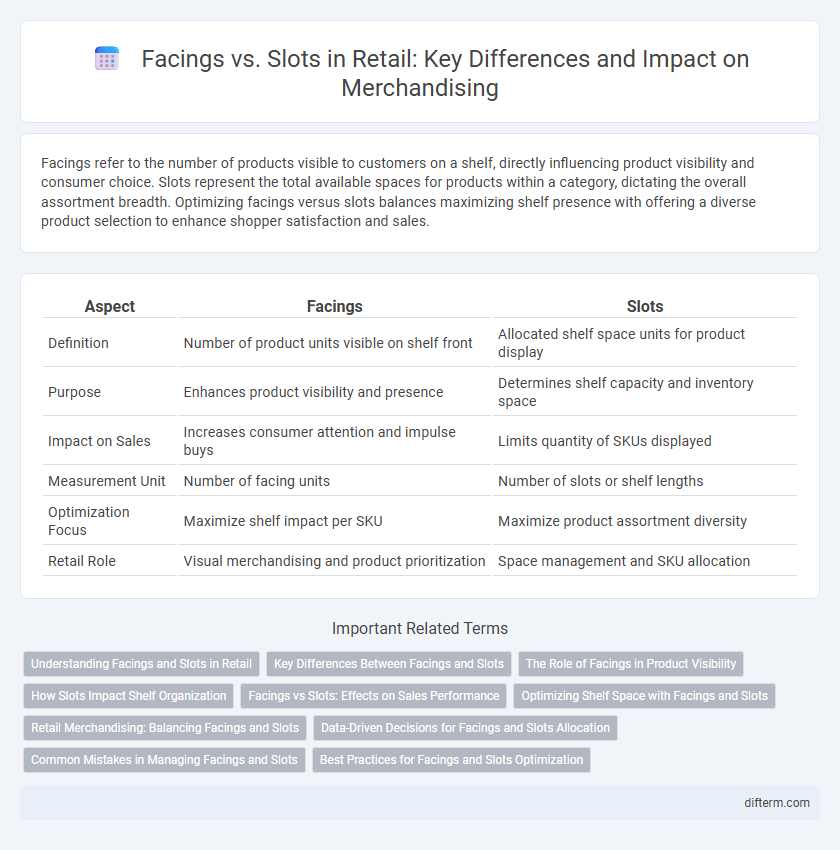Facings refer to the number of products visible to customers on a shelf, directly influencing product visibility and consumer choice. Slots represent the total available spaces for products within a category, dictating the overall assortment breadth. Optimizing facings versus slots balances maximizing shelf presence with offering a diverse product selection to enhance shopper satisfaction and sales.
Table of Comparison
| Aspect | Facings | Slots |
|---|---|---|
| Definition | Number of product units visible on shelf front | Allocated shelf space units for product display |
| Purpose | Enhances product visibility and presence | Determines shelf capacity and inventory space |
| Impact on Sales | Increases consumer attention and impulse buys | Limits quantity of SKUs displayed |
| Measurement Unit | Number of facing units | Number of slots or shelf lengths |
| Optimization Focus | Maximize shelf impact per SKU | Maximize product assortment diversity |
| Retail Role | Visual merchandising and product prioritization | Space management and SKU allocation |
Understanding Facings and Slots in Retail
Facings in retail refer to the number of product fronts visible to customers on a shelf, which directly impacts product visibility and sales potential. Slots denote the physical shelf space allocated for a product, usually measured in width or depth, influencing inventory capacity and assortment strategy. Optimizing the balance between facings and slots ensures effective shelf space utilization, enhancing both product prominence and customer choice.
Key Differences Between Facings and Slots
Facings refer to the number of product units visible to customers on a shelf, directly impacting product visibility and consumer choice. Slots denote the allocated space or position assigned to a product within a retail shelf system, determining inventory capacity and shelf organization. Understanding the key difference between facings and slots helps optimize shelf layout for increased sales and effective inventory management.
The Role of Facings in Product Visibility
Facings significantly enhance product visibility by increasing the number of product fronts displayed on shelves, making items more noticeable to shoppers. Unlike slots, which refer to allocated shelf space, facings emphasize the quantity of product exposure within those slots, directly influencing consumer purchasing decisions. Maximizing facings for high-demand products leads to improved sales performance and better inventory turnover in retail environments.
How Slots Impact Shelf Organization
Slots determine the precise placement and quantity of products on retail shelves, directly influencing shelf organization by controlling product visibility and accessibility. Efficient slot allocation maximizes space utilization, ensuring a balanced assortment that caters to consumer demand and streamlines inventory management. Optimizing slot distribution reduces stockouts and overstock situations, improving overall shelf turnover and enhancing the shopping experience.
Facings vs Slots: Effects on Sales Performance
Facings represent the number of product units visible to customers on the shelf, while slots refer to the physical spaces allocated for products. Increased facings can enhance product visibility and consumer preference, directly boosting sales performance. Optimizing the balance between facings and slots ensures maximum shelf impact, driving higher turnover rates and improving inventory management in retail environments.
Optimizing Shelf Space with Facings and Slots
Optimizing shelf space in retail requires balancing facings, the number of product fronts visible to customers, with slots, the individual compartments allocated on the shelf. Increasing facings enhances product visibility and brand presence, while efficient slot allocation maximizes inventory storage and minimizes stockouts. Analyzing sales data alongside customer behavior helps retailers strategically assign facings and slots to boost sales and inventory turnover.
Retail Merchandising: Balancing Facings and Slots
In retail merchandising, balancing facings and slots is essential for optimizing product visibility and inventory management. Increasing facings enhances product presence on shelves, driving consumer attention and sales, while allocating appropriate slots ensures efficient use of shelf space and accommodates a diverse product range. Strategic planning of facings versus slots maximizes shelf productivity, minimizes stockouts, and improves overall merchandising effectiveness.
Data-Driven Decisions for Facings and Slots Allocation
Data-driven decisions for facings and slots allocation enhance retail shelf optimization by analyzing sales velocity, product turnover, and consumer demand patterns. Leveraging point-of-sale data and inventory analytics enables precise adjustments to shelf facings, maximizing revenue per square foot and reducing stockouts. Integrating real-time data ensures dynamic slotting strategies that respond effectively to market trends and seasonal fluctuations.
Common Mistakes in Managing Facings and Slots
Confusing facings with slots often leads to inefficient shelf space utilization, resulting in poor product visibility and reduced sales. Overstocking multiple facings of low-demand products can limit the variety offered, while under-allocating slots for high-demand items causes stockouts and lost revenue. Retailers must carefully analyze sales data and consumer behavior to optimize both facings and slots, ensuring a balanced assortment that maximizes shelf productivity.
Best Practices for Facings and Slots Optimization
Optimizing facings and slots involves strategically increasing product visibility and accessibility to boost sales in retail environments. Best practices include analyzing sales velocity and consumer demand to allocate appropriate facings while ensuring slotting maximizes shelf space efficiency and product variety. Employing planogram software and demand forecasting tools helps retailers balance inventory turnover with shelf appearance, improving overall merchandising effectiveness.
facings vs slots Infographic

 difterm.com
difterm.com